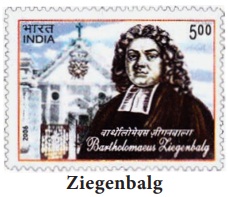Educational Development in India | Chapter 5 | History | 8th Social Science - Modern System of Education | 8th Social Science : History : Chapter 5 : Educational Development in India
Chapter: 8th Social Science : History : Chapter 5 : Educational Development in India
Modern System of Education
Modern System of Education
The beginning of the modern system
of Indian education can be traced to the efforts of the Christian missionaries
who arrived in India in the wake of European occupation. As a result of their
efforts, many institutions were established across India. These institutions
imparted Western as well as Indian education.
Role of Christian Missionaries
Europeans came to India for trade and
established trading companies. They acquired lands and constructed fortresses. Later
they wanted to spread their culture and religion among Indians. The Europeans
thought that they could makeIndians understand the administration and religious
theories better if they could impart education to the local population in their
own method. So they started educational institutions. The Portuguese were the
first Europeans who started modern system of education in India. Francis
Xavier, a Jesuit, started a university at Cochin. They started many primary
schools. The first college offering degrees on a completion of a course was
started in Goa in 1575 where Christianity, logic, grammar and music were
taught. John Kiernander was one of the most zealous pioneers and was perhaps
the first missionary in India to introduce education for non -Christian
children as an evangelistic agency. In 1812, Dr. C.S. John established 20 free
reading schools in Tranquebar.

Followed by the Portuguese, the French
opened their institutions for all the Indians where education was imparted by
Indian teachers through local languages. They started higher secondary schools
where French language was taught. Two German Bishops, named Ziegenbalg and
Plustscham, started schools and a training college for teachers in Travancore.
After the arrival of English East India Company in 1600 AD(CE), institutions
were established for imparting instruction in English. Gradually Sanskrit
colleges were opened in Madras and Benaras. The first Bishop of Calcutta, the
Revered Dr. Middleton, started a missionary college at Calcutta, which became
famous as the Bishop’s College. Mountstuart Elphinstone was actually a strong
advocate of vernacular education, but on his retirement in 1827, his admirers
collected funds and established a college offering English classes, named the
Elphinstone College at Bombay. Missionaries made a good deal of attempt for the
propagation of education in India. Due to their efforts many institutions were
established.These institutions imparted Western education as well as Indian
education.

Education in the British Rule
History of education in British rule
can be divided into four periods: (i) from the early days of the British rule
up to 1813; period from 1813–1853; (iii) period from 1854–1920 and (iv) period
from 1921–1947.
(i) From the early days of the British rule up
to 1813
During its early days, the East
India Company followed a policy of indifference and non-interference towards
education as this sector did not form a part of its programme. The Company's
charter was renewed in 1813, which compelled the Company to assume
responsibility for the education of Indians, though on a very limited scale.
Besides missionaries, non-missionaries like Raja Ram Mohan Roy of Bengal,
Pachyappar of Madras, W. Frazer of Delhi contributed to the cause of education.
In 1813, the East India
Company was compelled to assert the responsibility for the education of the
Indians. Charter of Act of 1813 made a provision for an annual grant of a sum
of 1 lakh rupees for the promotion of education in India.
(ii) Period from 1813–1853
The second period was also marked by
great educational controversies concerning the issues of educational policy,
medium of instruction and method of spreading education. First, there were the
orientalists who supported the preservation of Oriental learning and the use of
Sanskrit and Persian as the media of instruction. They were opposed by the
Anglicists who advocated dissemination of Western knowledge through English. A
third section believed in the use of Indian languages as the media of
instruction.

These controversies were partially set
at rest by Macaulay's Minutes of 1835. Higher education was de-orientalised, encouraging
English education for the upper classes. Each province was allowed to follow its
own education policy. But even then, the controversies continued till 1854.
(iii) Period from 1854–1920
The third phase of
British-influenced education may be called the period of an All-India
Educational Policy. It commenced with Sir Charles Wood’s Despatch in 1854.
Hunter Education commission started in 1882, gave emphasis to Primary
Education.
The Wood’s Despatch
(1854) is called the ‘Magna Carta’ of English education in India because it was
the first declaration of British education policy for educating the masses at
all levels. But it resulted in the complete control on state education,
divorcing it from Indian ideals and culture.
(iv) Period from 1921–1947
The fourth phase may be called the
period of provincial autonomy. The Act of 1935 ushered a new era of educational
advancement through the country. The new programmes were hit hard by the
worldwide economic depression in 1929. The introduction of complete provincial autonomy
by the Government of India Act of 1935 further strengthened the position of the
provincial ministers of education. After the Second World War, a very important
plan for educational development, known as the Sergeant Report (1944) was
prepared. This blueprint had a powerful influence on contemporary education,
both in thought as well as in practice.

Wardha Scheme of Education (1937)
In 1937, Gandhiji evolved a scheme populary known as the Wardha Scheme of Basic National Education. The principle of non-violence was the basis of Gandhiji scheme of Basic Education. Through this scheme he wanted to develop those qualities in future citizens of India which he considered necessary for building a non-violent society. His system of Education wanted to root out exploitation and centralization in society and create a non-violent social order.
Related Topics